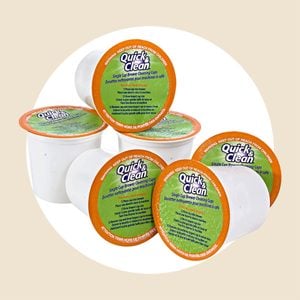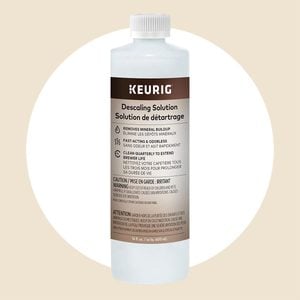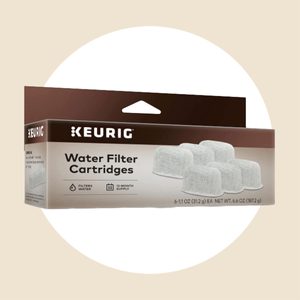How to Clean a Keurig Coffee Maker (Because Yours Probably Needs It!)
Updated: Aug. 09, 2023
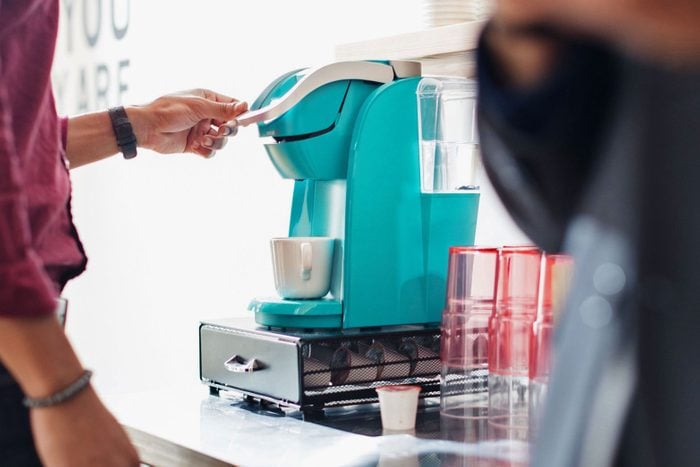
Get the most out of your single-serve coffee maker—and enjoy the best-tasting coffee—by learning how to clean a Keurig.
Our editors and experts handpick every product we feature. We may earn a commission from your purchases.
If your Keurig is serving up K-cup goodness for more than one person, more than once a day, read on. Sure, frequent coffee drinking does have its benefits, but using your Keurig daily—without taking the time to care for or maintain it—can have some pretty icky side effects.
Why do you need to clean a Keurig?
Cleaning a Keurig is a health and safety precaution. Like any other type of coffee maker, a Keurig can grow mold if it’s not properly drained, rinsed and cleaned. Aside from keeping mold and bacteria at bay, your Keurig should be cleaned on a regular basis so that it can perform to the best of its ability. A quick clean-up will remove the mineral buildup in the machine that affects the taste and quality of the coffee being brewed. A clean Keurig produces better quality coffee.
How often should you clean your Keurig?
Keurig highly recommends descaling a Keurig coffee maker every three to six months. This should help prevent calcium deposits or scale buildup from occurring. The other parts of the Keurig should be given more regular attention, though. If you brew a K-cup every day, then the Keurig’s exterior, cold water reservoir, drip tray and pod holder should all be cleaned once a week.
It might seem like one more chore to add to the list, but cleaning your Keurig regularly will extend the life of your machine and keep your morning (and afternoon, and evening) cup of coffee tasting fresh and strong.
What to clean Keurig with?
There’s a few different options for cleaning your Keurig. Household items like vinegar, water and citric acid work well (we walk you through how to use them below). When in doubt, Keurig cleaning pods or a descaling solution are available. They remove mineral buildup and get your Keurig brewing like new in minutes.
How to Clean Your Keurig
Tools and Supplies
- Keurig cleaning pods. These Keurig cleaning pods are just like coffee pods, except instead of dispensing coffee they descale the machine and remove residue buildup from the pod holder. Pop one in the pod holder, brew a large cup and dump whatever pours out. Then, run a large brew cycle with water only to rinse away the cleaning solution.
- Keurig descaler. It may take a little longer, but Keurig descaler is always a good option. It’s formulated with citric acid to safely clean the brewer. Just pour it in the empty water reservoir, add water and run several brew cycles to thoroughly clean the machine.
- Water filter cartridge. Finish your Keurig cleaning cycle by adding a water filter cartridge to the reservoir. It removes chlorine from the water tank, leaving you with great tasting coffee. Each cartridge lasts up to two months.
Directions
Follow these steps when properly learning how to clean your Keurig. Once you learn how to do it, you’ll remember the steps every time you clean. The first time, make sure to take a peek at your specific Keurig model’s recommendations to see if certain parts (like the water reservoir) can go in the dishwasher or not.
1. Take apart your Keurig
In order to clean everything as thoroughly as possible, you will want to disassemble your Keurig. You should be able to remove the drip tray, the water reservoir and lid, and the K-cup pod holder.
2. Wash removable parts and reassemble
After taking everything apart, wash the water reservoir with soap and water, and rinse thoroughly (because you don’t want soapy coffee!). Let the reservoir drip dry in order to avoid lint sticking to the sides that could eventually end up in your coffee cup.
Take this opportunity to clean out the needles that pierce your K-cup every morning, too. Take a straightened paper clip to loosen any coffee grounds that have gotten stuck.
Then, take a damp, soapy, lint-free cloth to wipe down the drip tray and the K-cup pod holder. After you reassemble, wipe down the exterior of your machine as well.
3. Descale the Keurig
Scale forms when calcium hardens and mineral deposits dry up within water. When you fill up a Keurig with water that has a high level of mineral content, it can cause buildup in the brewer and prevent it from working correctly. It also impacts the taste of your coffee. Yuck! But don’t worry. You can descale a Keurig using a few different methods:
How to Clean a Keurig with Keurig Cleaning Solution
Keurig has created and officially approved their own Keurig descaling solution, which is made for all Keurig 2.0 and 1.0 K-cup coffee makers.
Unplug and turn off the machine, then fill the water reservoir with one part Keurig Descaling Solution and one part water. Place a coffee mug underneath the dispenser, and brew one cup of hot water. Pour the water out once it’s done, replace the mug and repeat this step until all the water is gone out of the reservoir. Rinse the water reservoir, fill it up with fresh water, brew another cup of hot water and pour it out. Voila! A descaled Keurig.
How to Clean a Keurig with Vinegar and Water
Fill the water reservoir to the halfway mark with white distilled vinegar, which is key to removing scale buildup, and fill the other half with water. Begin the brew cycle sans K-cup, and repeat until the entire reservoir is empty. Once the water reservoir is completely empty, repeat with plain water to flush out the vinegar taste. (Seriously, what can’t vinegar clean!?)
Check out all of the easy vinegar uses there are to clean and brighten your home.
How to Clean a Keurig with Citric Acid
Like vinegar, citric acid is great for sanitizing a Keurig, and a simple homemade way to get rid of any scale that’s formed.
Prepare a citric acid solution by combining one to two tablespoons of citric acid with about four cups of water, and pour it into the water reservoir. Place a coffee mug underneath the drainage spout and brew a cup of hot water, then pour it out and repeat the step. Fill up the water reservoir with water again, and keep brewing until there’s nothing left in the reservoir.
You can find citric acid at spice shops or in your grocer’s canning aisle—or on Amazon.
How to Maintain a Keurig Between Cleanings
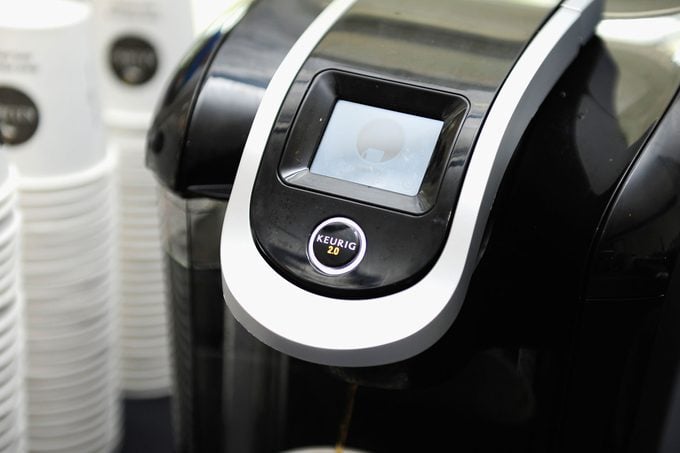
Keurig Rinse Pods
Keurig Rinse Pods are just the thing to keep your Keurig fresh weekly without doing a lot of work. To use, simply place a large mug on the Keurig drip tray. Lift the handle and insert a Keurig Rinse Pod, just like you would with a coffee capsule. Brew the rinse pod on the eight ounce brew setting. Remove and discard the rinse pod and the brewed rinse solution, then do an eight ounce water brew to completely rinse. Done!
You’ll taste the difference, especially if you use a variety of flavored coffee and tea pods. No more cross contamination between chai teas and cinnamon roll coffee flavors.
Keurig Water Cartridge Refills
If your tap water has a lot of chlorine, it will impact the taste of your coffee. Never fear. Keurig water cartridges help remove chlorine from the Keurig tank. For best results, replace the cartridge every two months or after 60 tank refills. Six water filter cartridges should last about a year, depending on how much coffee you’re brewing. And if you have a Keurig, we’re guessing you brew a lot of coffee!
When to Replace Your Keurig
Most Keurig customers say that their machines typically last for three to five years. But here are some other signs that might let you know when to replace your Keurig before then:
- Your coffee doesn’t come out piping hot. If your Keurig is brewing lukewarm coffee, get a new Keurig you can count on, or opt for one of our picks for the best coffee maker (just be sure you know how to clean a coffee maker instead, then!).
- Your Keurig takes more than a few minutes to brew a cup. Keurigs are built for speed! If your machine is struggling to keep up with your busy schedule, it might be time to move on.
- Your coffee is too watered down, or your Keurig is leaky. You don’t actually want your coffee to taste like bean water.
By knowing the best ways for how to clean a Keurig coffee maker, you’ll extend the life of your beloved caffeine machine. Sparkling clean, it will be one of your favorite appliances in the kitchen—even if you have some of these other cute kitchen appliances to boot. And if you love your Keurig, you won’t be able to resist these other Keurig accessories, either—like a personalized coffee bar mat or a Keurig decal that really makes your machine your own.
Wondering how to clean other kitchen appliances? We have guides for how to clean a microwave, how to clean an air fryer and how to clean the oven and dishwasher.

